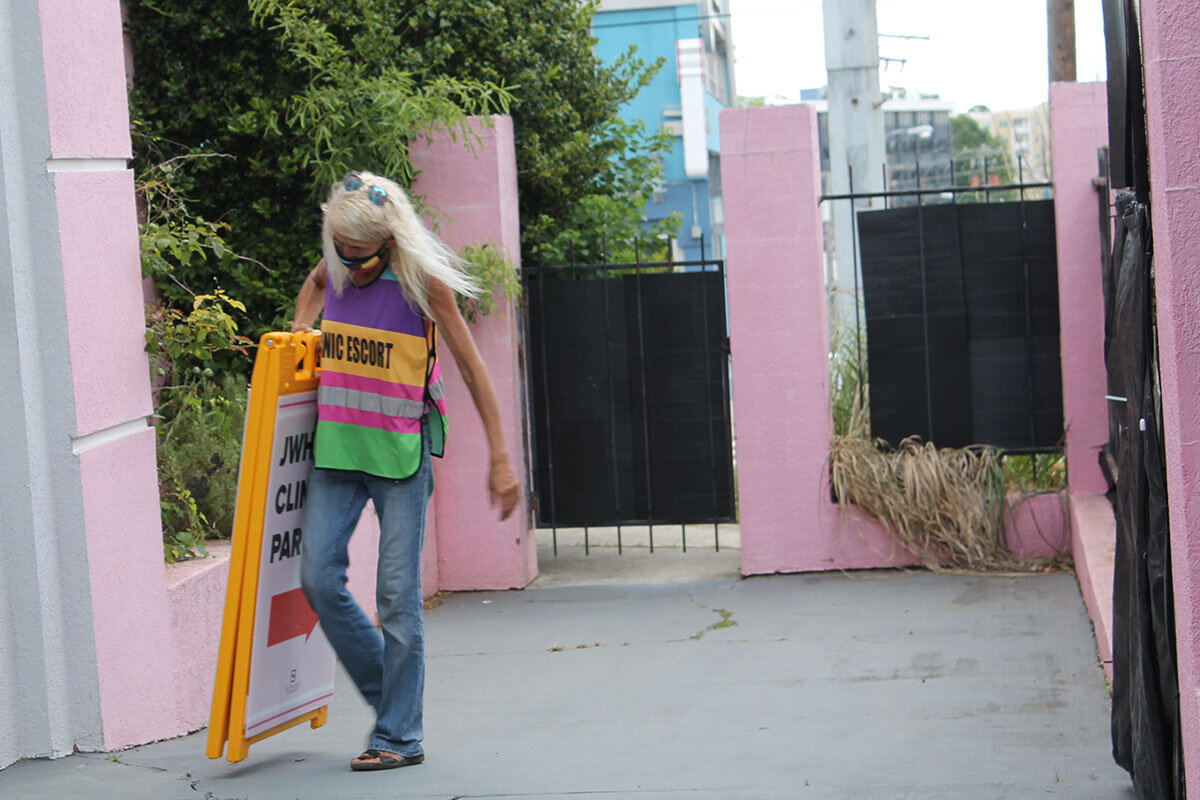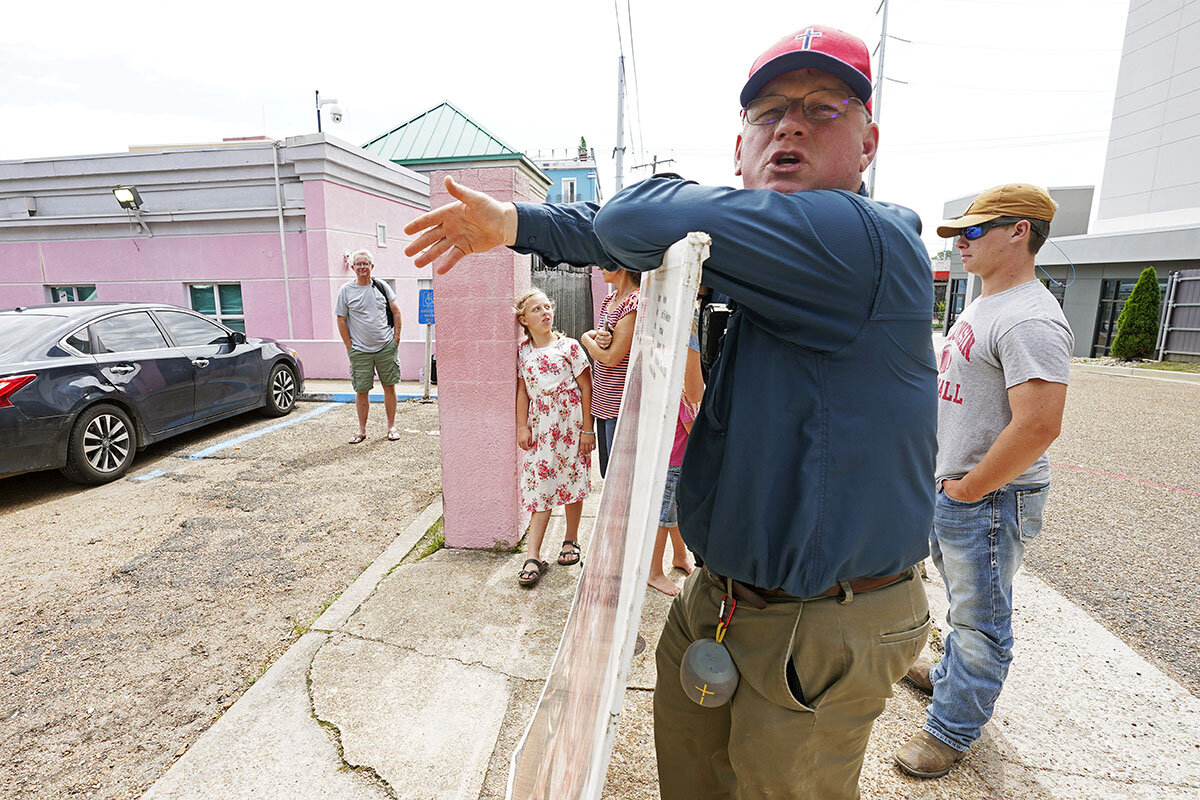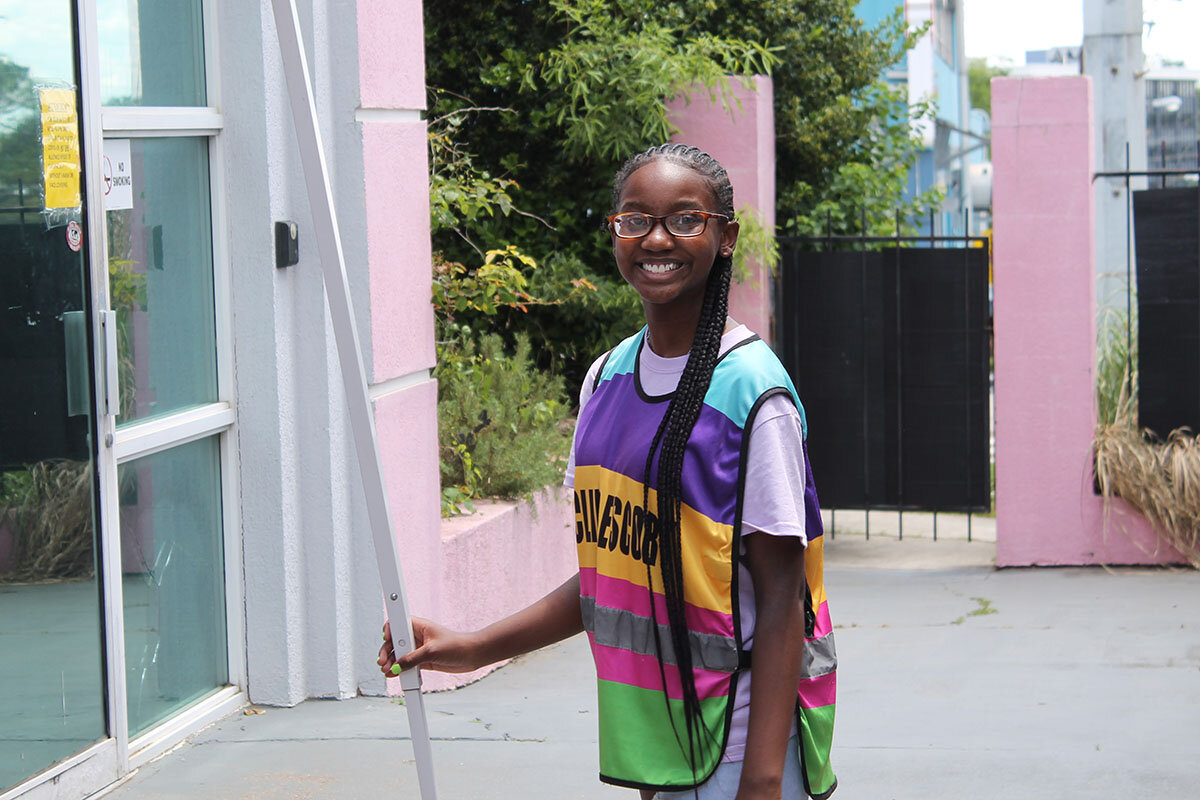Is Roe about to unravel? The view from Mississippi’s only abortion clinic.
Loading...
| Jackson, Miss.; and Irving, Texas
In 1988, Laura Duran felt the spiritual call to advocate against abortion access for women, and to save the lives that, in her view, are being taken with each procedure. That same year, Derenda Hancock walked into a women’s health clinic, received an abortion, and hasn’t regretted it since.
Although their decisions more than three decades ago helped send both women on divergent life trajectories, today they’re standing across the street from each other on a hot May afternoon in Jackson, Mississippi. As a woman walks into the Jackson Women’s Health Center, Ms. Duran walks after her, saying, “There are other choices.” Meanwhile, Ms. Hancock gently escorts the woman inside the building. “Ma’am,” Ms. Hancock calls out to the next woman to arrive. “Sweetheart,” to another.
Ms. Duran is an anti-abortion activist with the group Pro-Life Mississippi. Every day the center is open, she says, she stands outside, at times on her own, waiting for an opportunity to give the women entering the building pamphlets with titles like “I regret my abortion” and “I’m glad I chose life for me and my baby.”
Why We Wrote This
Abortion has been a focal point of America’s culture wars for almost 50 years. Now the last clinic in Mississippi is at center stage as the Supreme Court considers a highly charged case.
For the past eight years, Ms. Hancock has worked as a patient escort with the group the Pinkhouse Defenders, volunteers who wear rainbow-striped vests and guide each person through any protesters and into the facility.
The Jackson Women’s Health Center is an unobtrusive building on Jackson’s State Street, situated next to a trendy neighborhood, newly built high-rise apartments, and a bustling downtown corridor. It’s painted pink, hence the center’s nickname, the “pink house.”
It’s also the last abortion clinic in the state. And it is now at the center of a nation wrestling with the issue – as the U.S. Supreme Court has agreed to hear arguments later this year in a Mississippi case with the potential to dislodge America’s five-decade status quo on legal abortion.
A 2018 law in this state limits abortion access to the first 15 weeks of pregnancy. Currently blocked by lower courts, it will serve as a test for the newly expanded 6-3 conservative majority on the high court.
Volunteers at the health center say they understand the weight of the moment. In many ways, they realize, the burden of this highly charged national issue has landed on their shoulders.
“This is the place that everybody ignored and now it’s going to potentially overturn Roe v. Wade,” says Kim Gibson in a Mississippi twang. Ms. Gibson is the chair coordinator and a board member with the Pinkhouse Defenders. “Now,” she says, this case is “going to take away the rights of millions of people and possibly outlaw abortion in 24 or 25 states.”
She shakes her head at the thought.
“We’ve said for a couple years now,” Ms. Gibson adds, “ignore Mississippi at your own peril.”
A challenge to five decades under Roe
Mississippi’s 2018 Gestational Age Act prohibits abortions 15 weeks after gestation. That is considered to be before viability – the period between 22 and 24 weeks of development when a fetus is generally expected to be able to survive outside the womb. Since the U.S. Supreme Court’s ruling in Roe v. Wade almost 50 years ago, women have had the right to choose to have an abortion before viability.
Jackson Women’s Health challenged the law, and a federal judge and a federal appeals court blocked the state from implementing it, saying it violated Supreme Court precedents.
Mississippi appealed those rulings to the U.S. Supreme Court in June last year, asking the justices to answer three questions. Two questions were relatively incremental – asking to clarify the standard federal courts should use in analyzing abortion restrictions, and whether abortion providers should be allowed to challenge abortion restrictions. One, however, went directly to the constitutionality of certain abortion regulations.
The petition sat all summer without any action from the court. When the justices returned for their next term in the fall, much had changed. Justice Ruth Bader Ginsburg, a leader of the court’s liberal minority, had died. Amy Coney Barrett, a conservative federal appeals court judge, had been nominated to replace her by President Donald Trump, who was a month away from an election.
The case continued to sit. The justices considered it in 12 straight private conferences before announcing last month that they will hear it in the term starting this October. And tellingly, the court has restricted the case – Dobbs v. Jackson Women’s Health Org. – to the biggest question: whether all laws banning abortion pre-viability are unconstitutional.
The fact the court put off taking the case for so long “suggests there was a lot of wrangling” about what should be done with it, says Mary Ziegler, a professor at Florida State University College of Law.
And the fact the court dispensed with the other two questions suggests that it has little interest in moving slowly.
“If the court wanted to get its feet wet on abortion without addressing the core framework they could have done that, but they didn’t,” adds Professor Ziegler, author of “Abortion and the Law in America: Roe v. Wade to the Present.”
“I’d be a little surprised if the court overturns Roe in Dobbs,” she adds. “But certainly it seems to be a question of when they do it rather than if.”
Mississippi stated clearly in its petition that it’s not asking the court to overturn Roe or Planned Parenthood v. Casey, a 1992 case that upheld the core ruling in Roe while establishing that a state has “legitimate interests” in protecting “the life of the fetus that may become a child.” The case “merely ask[s] the Court to reconcile a conflict in its own precedents,” the state wrote. (Though the state did add, in a footnote, that if the court determines it can’t reconcile Roe and Casey, it “should not retain erroneous precedent.”)
And while the court recently overturned a precedent despite not being asked to, it’s unlikely the justices would do the same for an issue as contentious as abortion.
“Mississippi hasn’t asked for it, and the court hasn’t taken that issue,” says Clarke Forsythe, senior counsel at Americans United for Life.
The issue the court has taken – the so-called viability line – is, nevertheless, a significant one.
It’s a question that has vexed the justices since the early post-Roe years. In a 1983 case, Justice Sandra Day O’Connor wrote that the viability standard was unworkable, in part because the law cannot keep pace with medical advancements, forcing courts to “act as science review boards.”
In Dobbs, the Supreme Court will likely act that way again, this time weighing science that says viability begins around 23 weeks versus science saying it begins at 15 weeks.
“If the court is persuaded by [the latter] science I think they might well be prepared to abandon the viability timeline,” said Lyle Denniston, who has covered the court for over six decades, on the SCOTUStalk podcast last month.
“Viability has been a really, really thick line for 48 years. So abandoning that would be a huge deal,” he added. “Virtually anything might be possible under the new rubric of a fairly wide state power to limit abortion without the cutoff period of viability.”
What then? On that question, Dobbs will likely bring to boil a long-simmering debate in anti-abortion circles over how quickly and comprehensively the law should change.
Eight amicus briefs have already been filed in the case, and dozens more are expected before the case is argued next term. Some of them will probably make the case that all abortions are unconstitutional on the grounds that a fetus is legally a person entitled to equal protection under the Fourteenth Amendment – effectively turning Roe on its head.
No Supreme Court justice has embraced that argument yet, and it’s one that Mr. Forsythe and others in the anti-abortion movement criticize. Declaring all abortions unconstitutional would, in his view, represent a judicial fiat akin to Roe.
Roe “has made the justices in D.C. the center of abortion politics in American life, and that has been a disaster for the court, a disaster for the justices, a disaster for the judicial nomination and confirmation process,” says Mr. Forsythe.
“The court desperately needs to decentralize the issue and send it back to the states,” he adds. “Pro-life leaders need to think long and hard about overturning federalism and taking the issue away from the states.”
Public opinion – clear or complicated?
Public sentiment toward abortion access has remained consistent in recent years.
Prior to the 2020 presidential general election, pollsters asked specific questions about the Supreme Court’s Roe v. Wade decision, which legalized abortion access at the federal level in 1973. In a Quinnipiac poll, 66% of voters agreed with the court’s decision. Some 69% of respondents said they also agreed with the decision in a Kaiser Family Foundation poll, 62% in an ABC News-Washington Post poll, and 61% in a Fox News poll.
Given that, the effort by some state legislators to ban abortion altogether suggests that lawmakers are out of step with the general public. But there may be more to it than that, says Dr. Brandon Crawford, an assistant professor in the School of Public Health at Indiana University, Bloomington, who’s working to better understand that nuance through a multiyear abortion attitudes project.
In particular, Dr. Crawford says, it’s a matter of nuance in pollsters asking the question.
“On the one hand, [abortion] laws, a lot of times they’re framed as protecting a woman’s health. On the surface, I think people like that idea,” Dr. Crawford says. “But where it gets complicated is, do those laws actually achieve that end? Depending on what news you watch and what you read, some would say absolutely, and some would say not really.”
The polarization of the news cycle is, in part, likely to blame, Dr. Crawford says.
“But also,” he adds, “it’s difficult to communicate the full nuance of some of these issues. We like to think of things as having a clear yes or no answer. Some of them very well might, but other ones, maybe it’s a more complicated thing to discuss.”
For now, 2021 is shaping up to be a big year for the anti-abortion movement, especially in state level legislation.
As of mid-May, 549 abortion restrictions – among them, at least 165 abortion bans – have been introduced in 47 states since January, according to the research and policy organization the Guttmacher Institute. Already, 69 of those restrictions – nine of which are bans – have been enacted in 14 states, leading abortion access researchers to label this year as the most openly hostile to women’s bodily autonomy to date. Most recently, Texas approved a ban on abortions as early as six weeks.
The campaign against abortion access is being led by a rebranded group of activists who fashion themselves as “abortion abolitionists,” echoing the 19th-century anti-slavery movement. They want anyone who participates in the termination of a pregnancy, whether the woman, doctor, or nurse, to be prosecuted for homicide.
Ms. Duran, the lone anti-abortion advocate outside the Jackson Women’s Health Center last Thursday, is a soft-spoken woman whose long gray hair is tied in a bun. She frames her efforts around human rights.
“That baby has a right to live,” Ms. Duran says. “We have killed generations of people in general – doctors, nurses, lawyers, all these that could have been – because of convenience. And I’m against that.”
Ms. Duran then excuses herself to walk after a woman attempting to enter the center.
Asked whether anti-abortion activists have become increasingly agitated in recent months, Ms. Hancock, the volunteer patient escort, laughs under her breath and asks, “Who? Laura?”
The volunteers and protesters have become familiar with each other, Ms. Hancock says.
At times in recent years, the volunteers say, protests outside the building have become heated.
A wall of concrete blocks and steel gates, blocked with paneling for privacy, separate the health center’s entrance from the public walkway. On many mornings, the volunteers say, anti-abortion activists will stand on ladders outside the building, shouting with bull-horns in hand, looking at patients in the health center’s waiting room.
The harassment, volunteers say, has begun to weigh on them.
“If this harassment happened at a regular clinic or any other medical facility, it would be national news,” says Asia Brown, a college student who volunteers as a patient escort. “But because it’s an abortion clinic, people don’t want to talk about it.”
Meanwhile, the weight of the moment, Ms. Brown admits, “is on us.”
The Jackson Women’s Health Center only performs abortions up to 16 weeks. Under the Mississippi law, the cutoff to terminate most pregnancies would be 15.
“No big deal,” Ms. Hancock says. “It’s gonna affect maybe, at most, 2% of our patients.”
However, Mississippi also has a “trigger law” in the books, meaning the moment Roe is potentially overturned, the state, like others, would be able to ban all abortions within 24 hours.
Under those circumstances, the closest state for patients to travel to would be Georgia.
“They will not be satisfied until, as they like to call it, abortion is abolished,” Ms. Hancock says.
It’s just after noon, and the sun is hot and beaming.
The center’s volunteers – Ms. Hancock, Ms. Brown, and Ms. Gibson – gather in the shade before they begin packing up the health center for the day, taking the protective panels down.
“These different anti-choice groups, they come here, and they write their sample legislation and try to pass it here, because no one looks and no one cares,” Ms. Gibson says. “Then when it’s successful here and no one challenges, off they go to Alabama, to Georgia, to elsewhere.”
Once the anti-abortion groups are successful in the states friendliest to their efforts, she figures, they’ll move on to the next nearest state, where women would travel if their state bans abortion.
“It just crawls, but it starts here when Mississippi’s ignored,” Ms. Gibson says.









